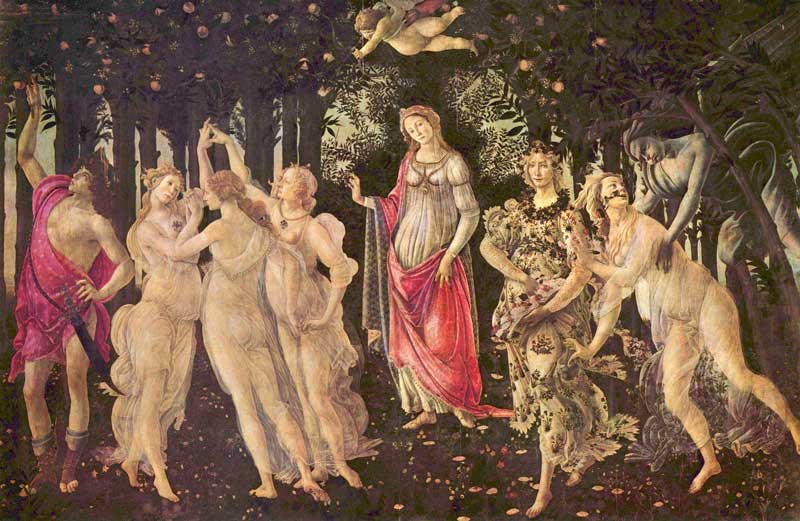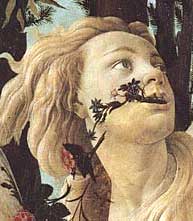.

Primavera (1478) by Sandro Botticelli. It is Spring, Nature's favorite season. The three Charites (Graces) are dancing, a Nymph (Chloris) spreads flowers. It's time for a new erotic adventure represented by Aphrodite (Venus) and her flying son Eros (who uses blind his bow). The wind Zephyrus captures Chloris. Only Hermes (as the Psychopompos who carries the soul of the persons who died to the underworld ) on the left side seems to ignore everything. He knows that death does not care what season it is.
Sandro Botticelli : Buy Fine Art Prints | Greeting Cards | iPhone Cases

The Graces, Detail

Chloris and Zephyrus from Primavera of Botticelli. The Children of Chloris and Zephyrus : Ampyx, Mopsus and Carpus. Zephyrus Roman mythological equivalent was Favonius, who held dominion over plants and flowers.

Flowers coming from the mouth of Chloris. She is shown twice in this painting, showing her transformation as described in a text by Ovid:
"As she talks, her lips breathe spring roses:
I was Chloris, who am now called Flora."

Flora
|
It ver et Venus, et Veneris praenuntius ante |
Spring and Venus go their way, and the winged harbinger of Venus steps on before; and close on Zephyr's footprints mother Flora strews all the way before them and covers it over with the choicest colours and odours |
-------------------------
SPRING
(BOTTICELLI)
MARCEL REYMOND
Of all the ancient Italian painters, Botticelli has, for several years, been the master most in fashion. Why? The first reason should be sought in that reaction against the pseudo-classic style of the Renaissance which has seemed to be the dominant tendency of art in the Nineteenth Century. But this explanation does not suffice to tell us for what reasons the favour of the public has specially fallen upon Botticelli. Why select Botticelli rather than any other artist of the Fourteenth or Fifteenth Century? Why Botticelli and not Giotto, or Fra Angelico, or, to cite none but his contemporaries, why not Signorelli, or Ghirlandajo? It is because Fra Angelico's art is too religious for our century and Giotto's art too philosophical, or, at least, it is because our century no longer thinks of demanding from its artists, as in the time of Giotto and Fra Angelico, the expression of the moral questions with which it is occupied. And if we seem to-day somewhat indifferent to the art of Ghirlandajo, or Signorelli, it is because their thought is too grave and because we desire before all else that art shall bring smiles into our laborious life; we demand that it shall give repose to our tired brains by charming us with the vision of all terrestrial beauties, without exacting any labour or any effort from our minds.
In this quest of beauty, our curious minds, which know so many things and which have been able to compare the works of the most diverse civilizations, are perpetually seeking novelty, eager for rare forms, and inimical to everything banal and to everything that ordinary life brings before our eyes. And in our fin de siècle we have been so much the more prone to subtle pursuits because for some time our French art has seemed to take delight in the forms of a gross realism.
This refinement of art, this intimate analysis of form and thought, this love of sensual beauty, had appeared at the court of the Medici by the same causes that prompt us to seek them; they are the fruit of a society that has attained the highest degree of well-being, wealth and knowledge.
This kind of art lasted only for a moment in Florence. It is correct to say that Florentine art did not seem destined to speak the charms of feminine beauty. From its beginning, this school had been stamped by Giotto with the philosophic impress, and for two centuries its artists had been before everything else, thinkers, occupied more with moral ideas than with the beauty of form.
The first in Florence to be enthralled by the charm of beautiful eyes was the poor Filippo Lippi. It was he who created that new form of art which was to continue with Botticelli, his pupil, and which attained its perfection under the hands of Leonardo. If, to the Lucrezia Buti of Filippo Lippi, we join Botticelli's Simonetta and Leonardo's Monna Lisa, we should have the poem of love sung by Florentine genius under its most exquisite form.
What Botticelli was, Spring will tell us; and this work is so significant, its essence expresses the thought of the master so clearly that it has preserved all its charm for us, although its particular meaning is not known to us. We call it Spring, but if one of the figures in the picture really represents Spring, it is only an accessory figure; and, moreover, this name given to the picture is entirety modern. Vasari says that it represents Venus surrounded by the Graces, but if we find the three Graces in the picture, it is not likely that the principal figure represents Venus. In my opinion, it is that principal figure that is the key to the picture; it is for this figure that everything has been done, and this it is, above all, that we must interrogate if we wish to know Botticelli's meaning. Evidently it is neither Venus, nor Spring; and the precision of the features, and the fidelity of the smallest details of the costume make us believe that we are in the presence of a veritable portrait.... Around her, Nature adorns herself with flowers; Spring and the Graces surround her like a train of Fays. Here is one of the familiar poetical forms of the Fifteenth Century; and, doubtless, by attentively reading the Florentine poets, we should discover the meaning of all the allegorical figures that Botticelli has united in his work and which we do not understand. 1
But whatever may be the particular meaning of each of these figures, it is certain that here we have to do with love and beauty, and that perhaps in no other work may we find the charm of woman described in more passionate accents.
In this world of feminine fascination Botticelli loved everything. He knows the attraction of the toilet and of jewels, but he knows above all that no gem and no invention of man can rival the beauty of the female form. He was the first to understand the exquisite charm of silhouettes, the first to linger in expressing the joining of the arm and body, the flexibility of the hips, the roundness of the shoulders, the elegance of the leg, the little shadow that marks the springing of the neck, and, above all, the exquisite carving of the hand. But, even more, he understood "le prestige insolent des grands yeux,"—large eyes, full, restless, and sad, because they are filled with love.
Look at these young maidens of Botticelli's. What a heavenly vision! Did Alfred de Musset know these veiled forms that seem to float over the meadow and did he think of them in the sleeplessness of his nights of May? Did he think of that young girl whose arm rises supple as the stem of a flower, of that young Grace so charming in the frame of her fair hair confined by strings of pearls, or, indeed, of that Primavera, who advances so imperiously beautiful, in her long robe of brocade, scattering handfuls of flowers that she makes blossom, or of that young mother more charming still in her modest grace, with her beautiful eyes full of infinite tenderness.
And around this scene, what a beautiful frame of verdure and flowers! Nature has donned her richest festal robes; the inanimate things, like the human beings, all speak of love and happiness, and tell us that the master of this world is that little child with bandaged eyes, who amuses himself by shooting his arrows of fire.
To say a word about the technique of this work, we should remark that Botticelli always painted in fresco or distemper, and that he did not seek the supple modelling that painting in oil affords; and, on the other hand, he submitted profoundly to the influence of Pollaiolo; he observed Nature with the eyes of a goldsmith; and he painted his works as if, working a niello or enamel, he had to set each figure in gold-wire.
Finally, is it necessary to speak of the date of the Primavera? This would occasion a long discussion if the space were accorded me. Let it suffice to say that the biography written by Vasari merits no credence, that it has been unfortunately accepted by the majority of historians, and that we have not yet a good chronology of Botticelli's works, nor even a simple catalogue. As for the chronology, most historians, relying upon Vasari, place nearly all of Botticelli's works before his trip to Rome in 1481. I think, on the contrary, and I will prove it elsewhere, that the great productive period of Botticelli belongs to the ten last years of the century and that the Primavera should be classed in this period. The Primavera represents, with The Birth of Venus and The Adoration of the Magi, the culminating point of Botticelli's art.
Jouin, Chefs-d'œuvre; Peinture, Sculpture, Architecture (Paris, 1895-97).
FOOTNOTES:
1
See notably the Stanze of Politian, where one will find nearly all the details of Botticelli's picture; the shady grove, the flowery meadow, even the attitudes and the garments of the personages. Is it not a figure of Botticelli's which is thus described:
"She is white and white is her robe,
All painted with flowers, roses, and blades of grass."
A 3D Version: http://www.mcs.csuhayward.edu/~malek/Illusions/RedBlue/Femme/Botticelli/Botticellif1rb.html
----
Fine Art Prints | Greeting Cards | Phone Cases | Lifestyle | Face Masks | Men's , Women' Apparel | Home Decor | jigsaw puzzles | Notebooks | Tapestries | ...
----
| Ancient Greece
Science, Technology , Medicine , Warfare, , Biographies , Life , Cities/Places/Maps , Arts , Literature , Philosophy ,Olympics, Mythology , History , Images Medieval Greece / Byzantine Empire Science, Technology, Arts, , Warfare , Literature, Biographies, Icons, History Modern Greece Cities, Islands, Regions, Fauna/Flora ,Biographies , History , Warfare, Science/Technology, Literature, Music , Arts , Film/Actors , Sport , Fashion --- |


